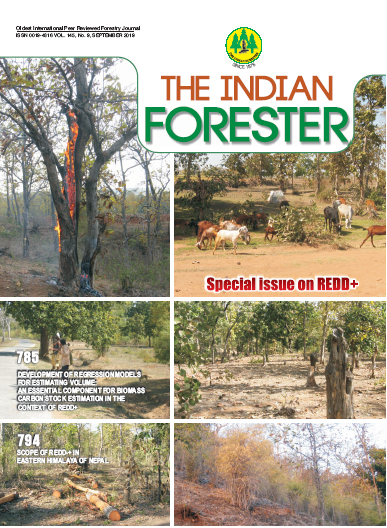Implementation of Biodiversity Safeguard for REDD+ Activities
DOI:
https://doi.org/10.36808/if/2019/v145i9/148681Keywords:
Biodiversity Safeguard, REDD , Parsa National Park, Bardia National Park.Abstract
Changes in climatic conditions attribute to changes in biodiversity and vice versa. Climate change identified as one of the main drivers of change in the Hindu Kush Himalayan region. There are Convention on Biological Diversity and the United Nations Framework Convention on Climate Change for addressing biodiversity and climate change issues respectively. In order to meet requirements under the Paris Agreements, the biodiversity safeguard for REDD+ will ensure no negative impact on biodiversity occurs while implementing REDD+ actions. Methodology and implementation results for biodiversity monitoring protocol for REDD+ in Parsa and Bardia National Parks of Nepal are highlighted, which is ERPD landscape of Nepal's first proposed REDD+ programme. The survey was carried out in order to provide baseline information for these areas. The Biodiversity Monitoring Protocol for REDD+ proves to be an important tool for incorporating biodiversity monitoring in the implementation of REDD+ activities.References
Allendorf T.D., Smith J.L.D. and Anderson D.H. (2007). Residents' perceptions of Royal Bardia National Park, Nepal. Landscape and Urban Planning, 82(1), 33-40.
Araujo M.B. and Rahbek C. (2006). How does climate change affect biodiversity? Science, 313(5792): 1396-1397.
Beebe J. (2014). Rapid qualitative inquiry: A field guide to team-based assessment. Rowman and Littlefield.
BPP (1995). Biodiversity Profiles Project, Department of National Parks and Wildlife Conservation, Kathmandu, Nepal.
DFRS (2015). State of Nepal's Forest. Forest Resource Assessment (FRA). Kathmandu, Nepal.
DNPWC (2017). Bardia National Park. Retrieved April 14, 2019, from http://www.bardianationalpark.gov.np/
Hampe A. and Petit R.J. (2005). Conserving biodiversity under climate change: the rear edge matters. Ecology Letters, 8(5): 461-467.
Krystufek B., VohralÃk V. and Obuch J. (2009). Endemism, vulnerability and conservation issues for small terrestrial mammals from the Balkans and Anatolia. Folia Zoologica, 58(3): 291-302.
MEA (2005). Millennium Ecosystem Assessment, 2005. Ecosystems and Human Well-being: Synthesis. Island Press, Washington, DC. World Health.
Resh V.H. (1995). Freshwater benthic macroinvertebrates and rapid assessment procedures for water quality monitoring in developing and newly industrialized countries. Biological Assessment and Criteria. Lewis Publishers, Boca Raton, Florida.
Resh V.H. and Jackson J.K. (1993). Rapid assessment approaches to biomonitoring using benthic macroinvertebrates. Chapman and Hall, New York (USA):195-223.
RIC (2018). Biodiversity Monitoring Protocol for REDD+. REDD Implementation Centre, Ministry of Forests and Soil Conservation, Government of Nepal.
Rosenberg D.M., Davies I.J., Cobb D.G., and Wiens A.P. (1998). Protocols for Measuring Biodiversity: Benthic Macroinvertebrates in Fresh Waters. Winnipeg, Manitoba.
Rovero F., Zimmermann F., Berzi D. and Meek P. (2013). Which camera trap type and how many do I need? A review of camera features and study designs for a range of wildlife research applications. Hystrix, 24(2):1-9.
Sharma C. (2003). Biological impacts and local perceptions of Tinau River Dam, Nepal.
Sharma S. and Moog O. (1996). The applicability of biotic indices and scores in water quality assessment of Nepalese rivers. In: Proceedings of the Ecohydrology Conference on High Mountain Areas, March 23-26, Kathmandu, Nepal, 641-657pp.
Van Laar A. and Akca A. (1997). Single-tree measurements. Forest Mensuration. Cuvillier Verlag, Gottingen, Germany, 82-122.
Wester P., Mishra A., Mukherji A. and Shrestha A.B. (2019). The Hindu Kush Himalaya Assessment- Mountains, Climate Change, Sustainability and People. Springer Nature Suitzerland AG, Chan+638pp.
Downloads
Downloads
Published
How to Cite
Issue
Section
License
Unless otherwise stated, copyright or similar rights in all materials presented on the site, including graphical images, are owned by Indian Forester.





